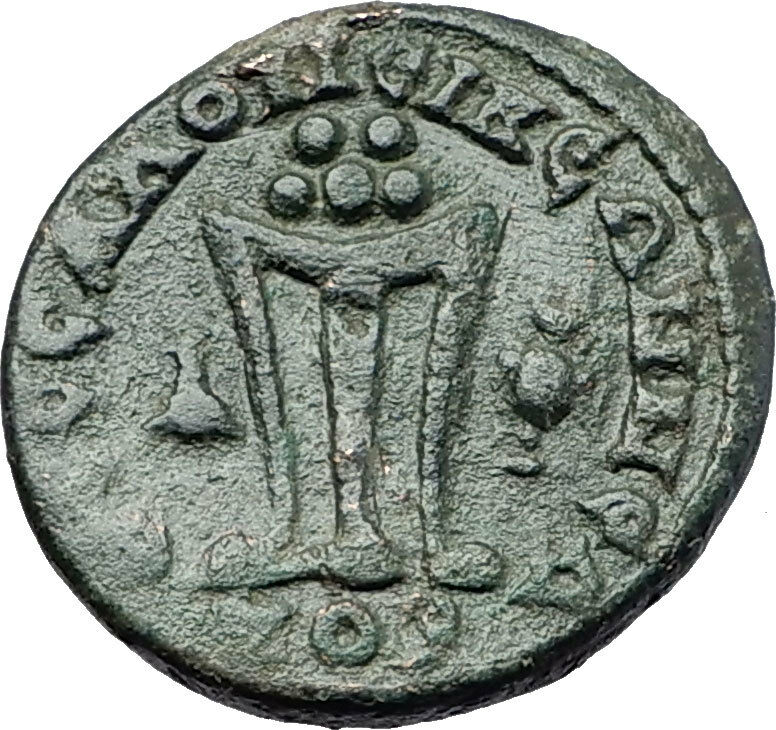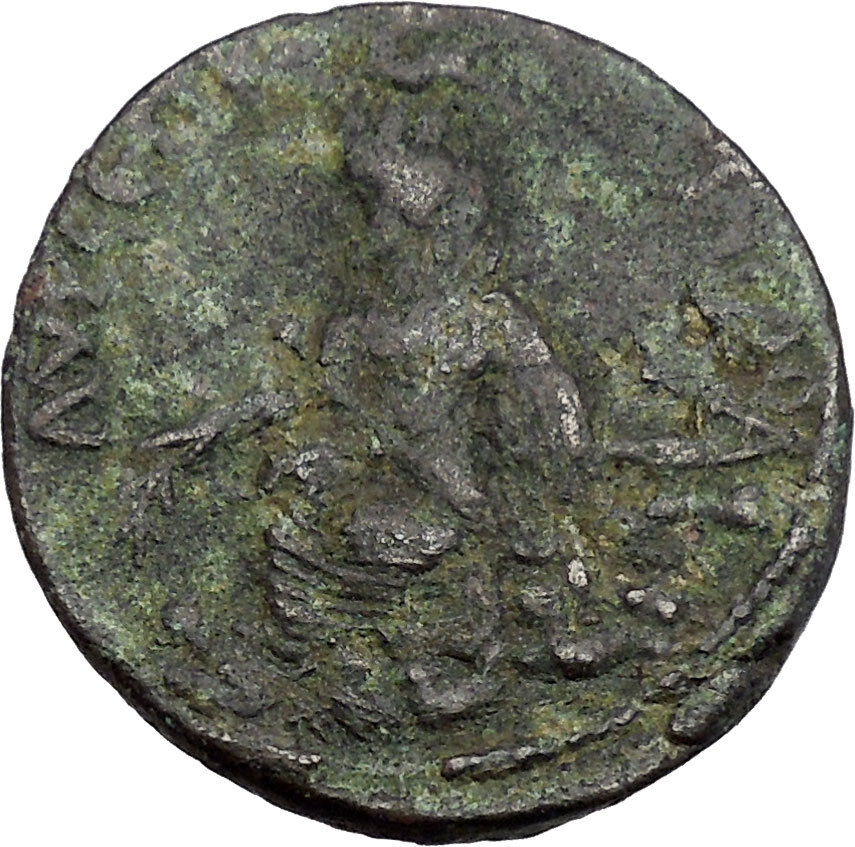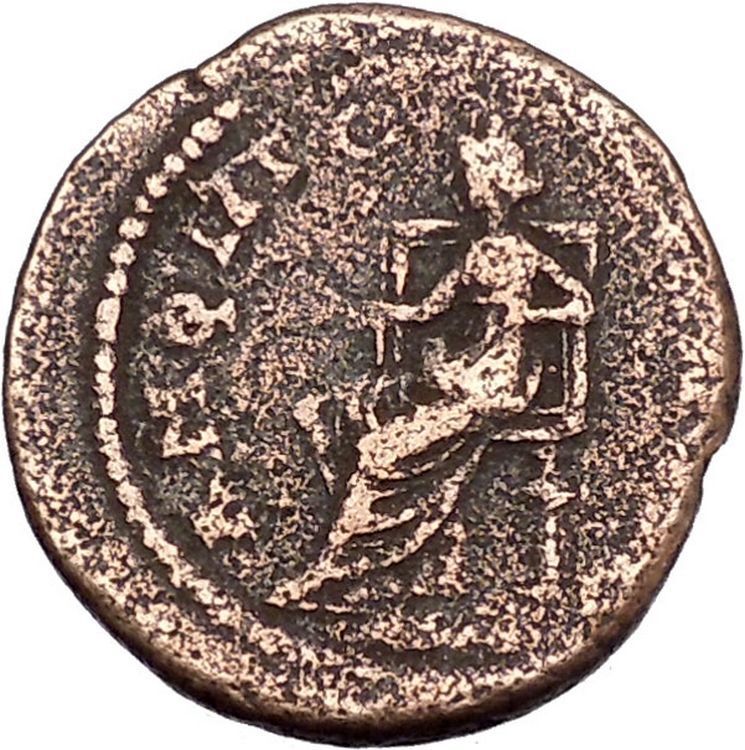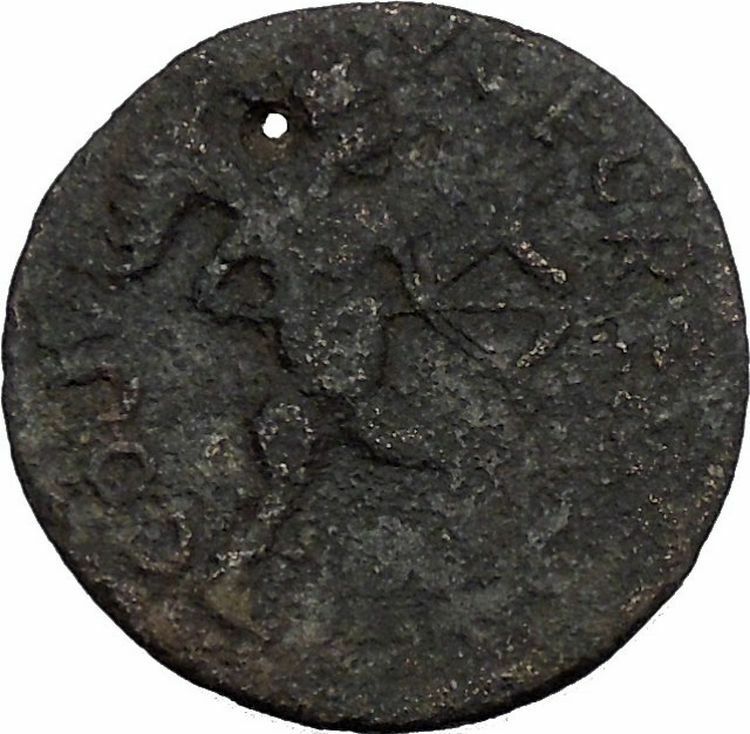|
Gallienus – Roman Emperor: 253-268 A.D. –
Bronze ‘Sestertius’ 25mm (9.95 grams) of the province of Dacia in Moesia
Superior.
Dated AN X = Year 10 = 256 AD.
Reference: Varbanov 92
IMP GALLIENVS PIVS AVG, laureate, draped, cuirassed bust right.
PROVINCIA DACIA, Dacia standing left, in long chiton & Phrygian cap, holding
standard inscribed XIII in left hand, to left standard inscribed V, to right of
Dacia lion (legion XIII) advancing left, to left of Dacia eagle (legion V) with
head turned right, wreath in beak, AN X in exergue.
This local era for Dacia begins in 246 AD, the year Philip expelled barbarian
invaders from the province. The lion and the eagle were the emblems of the
legions stationed in the province.
You are bidding on the exact
item pictured, provided with a Certificate of Authenticity and Lifetime
Guarantee of Authenticity.
Legio quinta Macedonica (Fifth Macedonian Legion)
was a Roman legion
. It was probably originally levied
by consul
Gaius Vibius Pansa Caetronianus
and
Octavian
in 43 BC, and it was stationed in
Moesia
at least until 5th century. Its symbol
was the bull, but the eagle was used as well. The
cognomen
Macedonica comes from the
fact that the legion was stationed in
Macedonia
for a significant period of its
existence.
History
1st century BC: Creation and deployment in Macedonia
The Legio V was one of the original twenty-eight legions raised by Octavian.
There are two fifth legions recorded: the V Gallica and the V Urbana.
It is possible that these both were early names for the V Macedonica. The
legion probably participated in the
Battle of Actium
(31 BC). It later moved to
Macedonia, where it stayed from 30 BC to AD 6, gaining its
cognomen
, before moving to
Oescus
(Moesia).
1st
century: The Great Jewish Revolt
In 62, some
vexillationes
of the Fifth fought under
Lucius Caesennius Paetus
in
Armenia
against the
Parthian Empire
. After the defeat of the
Battle of Rhandeia
, the whole V Macedonica,
together with
GallicaIII
,
FerrataVI
,
and
FretensisX
under the command of
Gnaeus Domitius Corbulo
, was sent to the east
to fight in the victorious war against the Parthians.
The Fifth was probably still in the East when the
Great Jewish Revolt
in
Iudaea Province
began in 66.
Nero gave the V Macedonica, the X Fretensis and the
ApollinarisXV
to Titus Flavius Vespasianus
to counter the
revolt. In 67, in Galilee
, the city of
Sepphoris
surrendered peacefully to the Roman
army, and later the V Macedonica conquered
Mount Gerizim
, the chief sanctuary of the
Samaritans
. In the
Year of the Four Emperors
, 68, the legion
stayed inactive in
Emmaus
, where several tombstones of soldiers of
the V Macedonica remain. After the proclamation of Vespasian as Emperor
and the end of the war under his son
Titus
, the V Macedonica left Iudaea and
returned to Oescus (71). In 96, the later emperor
Hadrian
served the legion as
tribunus militum
.
2nd century: In Dacia, protecting Danube frontier
In 101, the legion moved to
Dacia
, to fight in
Emperor Trajan’s
campaign against the king
Decebalus
. The legate of the V Macedonica
was future emperor
Hadrian
. After the war ended in 106, the legion
remained in Troesmis
(modern Iglita), near the
Danube Delta
since 107. A
centurion
of the legion,
Calventius Viator
, rose to prominence under
Hadrian. He was eventually promoted to commander of the emperors horse guards,
the equites singulares Augusti.
When Emperor
Lucius Verus
started his campaign against the
Parthians (161–166), the legion moved to the east, but was later returned in
Dacia Porolissensis, with a basecamp in
Potaissa
.
The northern frontier was a hot border of the Empire; when emperor
Marcus Aurelius
had to fight against the
Marcomanni
, the
Sarmatians
, and the
Quadi
, the V Macedonica was involved in
these fights.
At the beginning of the reign of
Commodus
, the V Macedonica and the
GeminaXIII
defeated once again the Sarmatians, under the later
usurpers
Pescennius Niger
and
Clodius Albinus
. The Fifth later supported
Septimius Severus
, in his fight for the purple.
In 185 or 187, the legion was awarded of the title Pia Constans
(“Faithful and reliable”) or Pia Fidelis (“Faithful and loyal”), after
defeating a mercenary army in Dacia.
Later
centuries: Honors and evolution
While staying in Potaissa for most of the 3rd century, V Macedonica
fought several times, earning honors.
Valerian
gave the Fifth the name III Pia III
Fidelis; his son,
Gallienus
gave the legion the title VII Pia
VII Fidelis, with the 4th, 5th and 6th titles awarded probably when the
legion was used as a mobile cavalry unit against usurpers
Ingenuus
and
Regalianus
(260, Moesia). A vexillatio fought
against Victorinus
(Gaul, 269–271).
The legion returned to
Oescus
in 274, after
Aurelian
had retired from Dacia. It guarded the
province in later centuries, becoming a
comitatensis
unit under the
Magister Militum per Orientis
. It probably
became part of the
Byzantine army
.
The cavalry unit created by Gallienus was definitively detached by
Diocletian
, and become part of his
comitatus
. This unit was sent to
Mesopotamia
, where it successfully fought
against the
Sassanid Empire
in 296, and then to
Memphis
, where it had to stay until its
entering in the Byzantine army.
Legio tertia decima Gemina (Thirteenth Twin Legion)
was one of the most prominent
Roman legions
. It was one of
Julius Caesar
‘s key units in
Gaul and in the
civil war
, and was the legion with which he
famously
crossed the Rubicon
on January 10, 49 BC. The
legion appears to have still been in existence in the fifth century. Its symbol
was the lion.
History
Under the late
Republic
Legio XIII was levied by
Julius Caesar
in 57 BC, before marching against
the Belgae
, in one of his early interventions in
intra-Gallic conflicts. During the
Gallic wars
(58-51 BC), Legio XIII was present
at the
Battle against the Nervians
, the
siege of Gergovia
, and while not specifically
mentioned in the sources, it is reasonable to assume that Legio XIII was also
present for the
Battle of Alesia
.
After the end of the Gallic wars, the
Roman senate
refused Caesar his second
consulship, ordered him to give up his commands, and demanded he return to
Rome to face prosecution. Forced to choose either the end of his
political career, or civil war, Caesar brought Legio XIII across the
Rubicon
river and into Italy. The legion
remained faithful to Caesar during the resulting civil war between Caesar and
the conservative
Optimates
faction of the senate, whose legions
were commanded by Pompey
. Legio XIII was active throughout the
entire war, fighting at
Dyrrhachium
(48 BC) and
Pharsalus
(48 BC). After the decisive victory
over Pompey at Pharsalus, the legion was to be disbanded, and the
legionaries
“pensioned off” with the
traditional land grants; however, the legion was recalled for the
Battle of Thapsus
(46 BC) and the final
Battle of Munda
(45 BC). After Munda, Caesar
disbanded the legion, retired his veterans, and gave them farmland in Italy.
Under the Empire
Augustus
reconstituted the legion once again in
41 BC to deal with rebellion of
Sextus Pompeius
(son of
Pompey
) in
Sicily
.
Legio XIII acquired the
cognomen
Gemina (“twin”, a common
appellation for legions constituted from portions of others) after being
reinforced with veteran
legionaries
from other legions following the
war against
Mark Antony
and the
Battle of Actium
. Augustus then sent the legion
to Burnum (modern
Knin), in
Illyricum
, a
Roman province
in the Adriatic Sea.
In 16 BC, the legion was transferred to Emona (now
Ljubljana
) in
Pannonia
, where they dealt with local
rebellions.
After the disaster of the
Battle of the Teutoburg Forest
in 9 AD, the
legion was sent as reinforcements to Augusta Vindelicorum (Augsburg),
and then to Vindonissa
,
Raetia
, to prevent further attacks from the
Germanic tribes.
Emperor Claudius
sent them back to Pannonia around 45;
the legion camped at
Poetovio
(modern
Ptuj, Slovenia).
In the
year of the four emperors
(69), XIII Gemina
supported first Otho
and then
Vespasian
against
Vitellius
, fighting in the two
Battles of Bedriacum
.
Under Trajan
the Legion took part in both
Dacian wars
(101-102, 105-106), and it was
transferred by Trajan in 106 to the newly conquered province of Dacia (in Apulum,
modern Alba Iulia
, Romania) to garrison it.
Vexillationes
of the XIII Gemina
fought under Emperor
Gallienus
in northern Italy. The emperor issued
a legionary
antoninianus
celebrating the legion, and
showing the legion’s lion (259-260).[3]
Another vexillatio was present in the army of the emperor of the
Gallic Empire
Victorinus
: this emperor, in fact, issued a
gold coin celebrating the legion and its emblem.[4]
In 271, the legion was relocated when the Dacia province was evacuated, and
restationed in
Dacia Aureliana
.
In the 5th century, according to the
Notitia Dignitatum
, a legio tertiadecima
gemina was in
Babylon in Egypt
, a strategic fortress on the
Nile at the traditional border between
Lower Egypt
and
Middle Egypt
, under the command of the Comes
limitis Aegypti.
Fictional accounts
- A fictionalized account of the actions of Legio XIII Gemina
during the struggle between
Julius Caesar
and the
Optimates
faction under
Pompey
can be seen in the joint
HBO
/BBC/RAI
television production
Rome
, most notably two of its
soldiers: Tribune
Lucius Vorenus
and
Legionary
Titus Pullo
, named after real-life
Centurions
Lucius Vorenus
and
Titus Pullo
of the XI Legion.
Legacy
On June 15, 2008, the 4th Romanian Territorial Corps became the
4th Infantry Division (Romania)
“Gemina”.
In ancient geography, especially in
Roman
sources,
Dacia was the land
inhabited by the Dacians
and
Getae
– the North-Danubian branches of the
Thracians
. Dacia had in the middle the
Carpathian Mountains
and was bounded
approximately by the
Danubius
river, in Greek sources Istros
(the Danube
) or, at its greatest extent, by the
Haemus Mons
(the
Balkan Mountains
) to the south–Moesia
(Dobrogea),
a region south of the Danube, was a core area where the Getae lived and
interacted with the Ancient Greeks–Pontus
Euxinus (the
Black Sea
) and river Danastris, in Greek
sources Tyras (the
Dniester
) to the east (but several Dacian
settlements are recorded in part of area between Dniester and Hypanis
river (the Bug
), and
Tisia
(the
Tisza
) to the west (but at times included areas
between Tisza and middle Danube). It thus corresponds to modern countries of
Romania
and
Moldova
, as well as smaller parts of
Bulgaria
,
Serbia
,
Hungary
, and
Ukraine
.
Dacians and Getae were North
Thracian
tribes. Dacian tribes had both
peaceful and military encounters with other neighboring tribes, such as
Celts
,
Ancient Germanics
,
Sarmatians
, and
Scythians
, but were most influenced by the
Ancient Greeks and
Romans
. The latter eventually conquered, and
linguistically and culturally assimilated the Dacians. A Dacian Kingdom of
variable size existed between 82 B.C. until the Roman conquest in 106 A.D. The
capital of Dacia,
Sarmizegetusa
, located in modern Romania, was
destroyed by the Romans, but its name was added to that of the new city (Ulpia
Traiana Sarmizegetusa) built by the latter to serve as the capital of the
Roman province of Dacia
.
Gallienus (Latin:
Publius Licinius Egnatius Gallienus Augustus;
c. 218 – 268) was
Roman Emperor
with his father
Valerian
from 253 to 260 and alone from 260 to
268. He ruled during the
Crisis of the Third Century
that nearly caused
the collapse of the empire. While he won a number of military victories, he was
unable to prevent the secession of important provinces.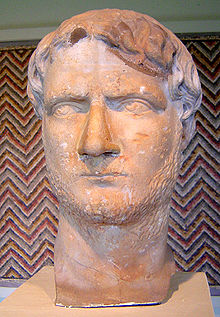
Life
Rise to power
The exact birth date of Gallienus is unknown. The Greek chronicler
John Malalas
and the Epitome de Caesaribus
report that he was about 50 years old at the time of his death, meaning he was
born around 218. He was the son of emperor
Valerian
and
Mariniana
, who may have been of senatorial
rank, possibly the daughter of
Egnatius Victor Marinianus
, and his brother was
Valerianus Minor
. Inscriptions on coins connect
him with Falerii
in
Etruria
, which may have been his birthplace; it
has yielded many inscriptions relating to his mother’s family, the Egnatii.[3]
Gallienus married
Cornelia Salonina
about ten years before his
accession to the throne. She was the mother of three princes:
Valerian II
, who died in 258;
Saloninus
, who was named co-emperor but was
murdered in 260 by the army of general Postumus; and
Marinianus
, who was killed in 268, shortly
after his father was assassinated.
When
Valerian
was proclaimed Emperor on 22 October
253, he asked the
Senate
to ratify the elevation of Gallienus to
Caesar and
Augustus
. He was also designated
Consul Ordinarius
for 254. As
Marcus Aurelius
and his adopted brother
Lucius Verus
had done a century earlier,
Gallienus and his father divided the Empire. Valerian left for the East to stem
the Persian threat, and Gallienus remained in Italy to repel the Germanic tribes
on the Rhine
and
Danube
.
Division of the empire
had become necessary due
to its sheer size and the numerous threats it faced, and it facilitated
negotiations with enemies who demanded to communicate directly with the emperor.
Early
reign and the revolt of Ingenuus
Gallienus spent most of his time in the provinces of the Rhine area (Germania
Inferior,
Germania Superior
,
Raetia
, and
Noricum
), though he almost certainly visited
the Danube
area and
Illyricum
during 253 to 258. According to
Eutropius and Aurelius Victor, he was particularly energetic and successful in
preventing invaders from attacking the German provinces and Gaul, despite the
weakness caused by Valerian’s march on Italy against
Aemilianus
in 253. According to numismatic
evidence, he seems to have won many victories there, and a victory in
Roman Dacia
might also be dated to that period.
Even the hostile Latin tradition attributes success to him at this time.
In 255 or 257, Gallienus was made Consul again, suggesting that he briefly
visited Rome on those occasions, although no record survives. During his Danube
sojourn (Drinkwater suggests in 255 or 256), he proclaimed his elder son
Valerian II
Caesar and thus official heir to
himself and Valerian I; the boy probably joined Gallienus on campaign at that
time, and when Gallienus moved west to the Rhine provinces in 257, he remained
behind on the Danube as the personification of Imperial authority.
Sometime between 258 and 260 (the exact date is unclear), while Valerian was
distracted with the ongoing invasion of Shapur in the East, and Gallienus was
preoccupied with his problems in the West,
Ingenuus
, governor of at least one of the
Pannonian provinces, took advantage and declared himself emperor. Valerian II
had apparently died on the Danube, most likely in 258. Ingenuus may have been
responsible for that calamity. Alternatively, the defeat and capture of Valerian
at the
battle of Edessa
may have been the trigger for
the subsequent revolts of Ingenuus,
Regalianus
, and
Postumus
. In any case, Gallienus reacted with
great speed. He left his son
Saloninus
as Caesar at
Cologne
, under the supervision of Albanus (or
Silvanus) and the military leadership of Postumus. He then hastily crossed the
Balkans
, taking with him the new cavalry corps
(comitatus) under the command of
Aureolus
and defeated Ingenuus at
Mursa
or
Sirmium
.The victory must be attributed mainly
to the cavalry and its brilliant commander. Ingenuus was killed by his own
guards or committed suicide by drowning himself after the fall of his capital,
Sirmium.
Invasion of the
Alamanni
A major invasion by the
Alemanni
and other Germanic tribes occurred
between 258 and 260 (it is hard to fix the precise date of these
events),probably due to the vacuum left by the withdrawal of troops supporting
Gallienus in the campaign against Ingenuus.
Franks
broke through the lower Rhine, invading
Gaul, some reaching as far as southern Spain, sacking Tarraco (modern
Tarragona
).The Alamanni invaded, probably
through
Agri Decumates
(an area between the upper Rhine
and the upper Danube), likely followed by the
Juthungi
. After devastating Germania Superior
and Raetia (parts of southern
France
and
Switzerland
), they entered Italy, the first
invasion of the Italian peninsula, aside from its most remote northern regions,
since Hannibal
500 years before. When invaders
reached the outskirts of Rome, they were repelled by an improvised army
assembled by the Senate, consisting of local troops (probably prǣtorian guards)
and the strongest of the civilian population.On their retreat through northern
Italy, they were intercepted and defeated in the
battle of Mediolanum
(near present day
Milan
) by Gallienus’ army, which had advanced
from Gaul, or from the Balkans after dealing with the Franks.The battle of
Mediolanum was decisive, and the Alamanni didn’t bother the empire for the next
ten years. The Juthungi managed to cross the Alps with their valuables and
captives from Italy. An historian in the 19th century suggested that the
initiative of the Senate gave rise to jealousy and suspicion by Gallienus, thus
contributing to his exclusion of senators from military commands.
The revolt of
Regalianus
Around the same time,
Regalianus
, a military commander of
Illyricum
, was proclaimed Emperor. The reasons
for this are unclear, and the Historia Augusta (almost the sole resource
for these events) does not provide a credible story. It is possible the seizure
can be attributed to the discontent of the civilian and military provincials,
who felt the defense of the province was being neglected.
Regalianus held power for some six months and issued coins bearing his image.
After some success against the
Sarmatians
, his revolt was put down by the
invasion of Roxolani
into
Pannonia
, and Regalianus himself was killed
when the invaders took the city of
Sirmium
. There is a suggestion that Gallienus
invited Roxolani to attack Regalianus, but other historians dismiss the
accusation.It is also suggested that the invasion was finally checked by
Gallienus near Verona
and that he directed the restoration of
the province, probably in person.
Capture of Valerian, revolt of Macrianus
In the East, Valerian was confronted with serious troubles. A band of
Scythians
set a naval raid against
Pontus
, in the northern part of modern Turkey.
After ravaging the province, they moved south into
Cappadocia
. Valerian led troops to intercept
them but failed, perhaps because of a plague that gravely weakened his army, as
well as the contemporary invasion of northern
Mesopotamia
by
Shapur I
, ruler of the
Sassanid Empire
.
In 259 or 260, the Roman army was defeated in the
Battle of Edessa
, and Valerian was taken
prisoner. Shapur’s army raided
Cilicia
and
Cappadocia
(in present day
Turkey
), sacking, as Shapur’s inscriptions
claim, 36 cities. It took a rally by an officer
Callistus
(Balista), a fiscal official named
Fulvius Macrianus
, the remains of the Eastern
Roman legions, and
Odenathus
and his
Palmyrene
horsemen to turn the tide against
Shapur. The Persians were driven back, but Macrianus proclaimed his two sons
Quietus
and
Macrianus
(sometimes misspelled Macrinus) as
emperors. Coins struck for them in major cities of the East indicate
acknowledgement of the usurpation. The two Macriani left Quietus, Ballista, and,
presumably, Odenathus to deal with the Persians while they invaded Europe with
an army of 30,000 men, according to the Historia Augusta. At first they
met no opposition. The Pannonian legions joined the invaders, being resentful of
the absence of Gallienus. He sent his successful commander Aureolus against the
rebels, however, and the decisive battle was fought in the spring or early
summer of 261, most likely in Illyricum, although
Zonaras
locates it in Pannonia. In any case,
the army of the usurpers surrendered, and their two leaders were killed.
In the aftermath of the battle, the rebellion of Postumus had already
started, so Gallienus had no time to deal with the rest of the usurpers, namely
Balista and Quietus. He came to an agreement with Odenathus, who had just
returned from his victorious Persian expedition. Odenathus received the title of
dux Romanorum and besieged the usurpers, who were based at
Emesa
. Eventually, the people of Emesa killed
Quietus, and Odenathus arrested and executed Balista about November 261.
The revolt of Postumus
After the defeat at Edessa, Gallienus lost control over the provinces of
Britain, Spain, parts of Germania, and a large part of Gaul when another
general, Postumus
, declared his own realm (usually known
today as the
Gallic Empire
). The revolt partially coincided
with that of
Macrianus
in the East. Gallienus had installed
his son Saloninus and his guardian,
Silvanus
, in Cologne in 258. Postumus, a
general in command of troops on the banks of the Rhine, defeated some raiders
and took possession of their spoils. Instead of returning it to the original
owners, he preferred to distribute it amongst his soldiers. When news of this
reached Silvanus, he demanded the spoils be sent to him. Postumus made a show of
submission, but his soldiers mutinied and proclaimed him Emperor. Under his
command, they besieged Cologne, and after some weeks the defenders of the city
opened the gates and handed Saloninus and Silvanus to Postumus, who had them
killed. The dating of these events is not accurate, but they apparently occurred
just before the end of 260. Postumus claimed the consulship for himself and one
of his associates, Honoratianus, but according to D.S. Potter, he never tried to
unseat Gallienus or invade Italy.
Upon receiving news of the murder of his son, Gallienus began gathering
forces to face Postumus. The invasion of the Macriani forced him to dispatch
Aureolus with a large force to oppose them, however, leaving him with
insufficient troops to battle Postumus. After some initial defeats, the army of
Aureolus, having defeated the Macriani, rejoined him, and Postumus was expelled.
Aureolus was entrusted with the pursuit and deliberately allowed Postumus to
escape and gather new forces. Gallienus returned in 263 or 265 and surrounded
Postumus in an unnamed Gallic city. During the siege, Gallenus was severely
wounded by an arrow and had to leave the field. The standstill persisted until
the death of Gallienus, and the
Gallic Empire
remained independent until 274.
The revolt of
Aemilianus
In 262, the mint in
Alexandria
started to again issue coins for
Gallienus, demonstrating that Egypt had returned to his control after
suppressing the revolt of the Macriani. In spring of 262, the city was wrenched
by civil unrest as a result of a new revolt. The rebel this time was the prefect
of Egypt,
Lucius Mussius Aemilianus
, who had already
given support to the revolt of the Macriani. The correspondence of bishop
Dionysius of Alexandria
provides a colourful
commentary on the sombre background of invasion, civil war, plague, and famine
that characterized this age.
Knowing he could not afford to lose control of the vital Egyptian granaries,
Gallienus sent his general Theodotus against Aemilianus, probably by a naval
expedition. The decisive battle probably took place near Thebes, and the result
was a clear defeat of Aemilianus. In the aftermath, Gallienus became Consul
three more times in 262, 264, and 266.
Herulian invasions, revolt of Aureolus, conspiracy and death
In the years 267–269, Goths and other barbarians invaded the empire in great
numbers. Sources are extremely confused on the dating of these invasions, the
participants, and their targets. Modern historians are not even able to discern
with certainty whether there were two or more of these invasions or a single
prolonged one. It seems that, at first, a major naval expedition was led by the
Heruli
starting from north of the
Black Sea
and leading in the ravaging of many
cities of Greece (among them,
Athens
and
Sparta
). Then another, even more numerous army
of invaders started a second naval invasion of the empire. The Romans defeated
the barbarians on sea first. Gallienus’ army then won a battle in
Thrace
, and the Emperor pursued the invaders.
According to some historians, he was the leader of the army who won the great
Battle of Naissus
, while the majority believes
that the victory must be attributed to his successor,
Claudius II
.
In 268, at some time before or soon after the battle of Naissus, the
authority of Gallienus was challenged by
Aureolus
, commander of the cavalry stationed in
Mediolanum
(Milan),
who was supposed to keep an eye on
Postumus
. Instead, he acted as deputy to
Postumus until the very last days of his revolt, when he seems to have claimed
the throne for himself. The decisive battle took place at what is now
Pontirolo Nuovo
near Milan; Aureolus was
clearly defeated and driven back to Milan. Gallienus laid siege to the city but
was murdered during the siege. There are differing accounts of the murder, but
the sources agree that most of Gallienus’ officials wanted him dead. According
to the
Historia Augusta
, an unreliable source compiled
long after the events it describes, a conspiracy was led by the commander of the
guard
Aurelius Heraclianus
and Marcianus.
Cecropius, commander of the Dalmatians, spread the word that the forces of
Aureolus were leaving the city, and Gallienus left his tent without his
bodyguard, only to be struck down by Cecropius.One version has Claudius selected
as Emperor by the conspirators, another chosen by Gallienus on his death bed;
the Historia Augusta was concerned to substantiate the descent of the
Constantinian dynasty
from Claudius, and this
may explain its accounts, which do not involve Claudius in the murder. The other
sources (Zosimus
i.40 and
Zonaras
xii.25) report that the conspiracy was
organized by Heraclianus, Claudius, and
Aurelian
.
According to Aurelius Victor and Zonaras, on hearing the news that Gallienus
was dead, the Senate in Rome ordered the execution of his family (including his
brother Valerianus and son Marinianus) and their supporters, just before
receiving a message from Claudius to spare their lives and deify his
predecessor.
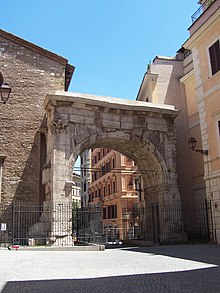
Arch of Gallienus
in Rome, 262 –
dedicated to, rather than built by, Gallienus.
Legacy
Gallienus was not treated favorably by ancient historians, partly due to the
secession of Gaul and
Palmyra
and his inability to win them back.
According to modern scholar Pat Southern, some historians now see him in a more
positive light.Gallienus produced some useful reforms. He contributed to
military history as the first to commission primarily
cavalry
units, the
Comitatenses
, that could be dispatched anywhere
in the Empire in short order. This reform arguably created a precedent for the
future emperors
Diocletian
and
Constantine I
.
The biographer
Aurelius Victor
reports that Gallienus forbade
senators
from becoming military commanders.
This policy undermined senatorial power, as more reliable
equestrian
commanders rose to prominence. In
Southern’s view, these reforms and the decline in senatorial influence not only
helped Aurelian to salvage the Empire, but they also make Gallienus one of the
emperors most responsible for the creation of the
Dominate
, along with
Septimius Severus
, Diocletian, and Constantine
I.
By portraying himself with the attributes of the gods on his coinage,
Gallienus began the final separation of the Emperor from his subjects.A late
bust of Gallienus (see above) depicts him with a largely blank face, gazing
heavenward, as seen on the famous stone head of
Constantine I
. One of the last rulers of Rome
to be theoretically called “Princeps”, or First Citizen, Gallienus’ shrewd
self-promotion assisted in paving the way for those who would be addressed with
the words “Dominus et Deus” (Lord and God).
-
Antoninianus
issued to celebrate
LEG II ITAL VII P VII F, “ItalicaLegio
II seven
times faithful and loyal.”
-
Antoninianus issued to celebrate LEG III ITAL VI P VI F,
“ItalicaLegio
III six times
faithful and loyal.”
-
Antoninianus issued to celebrate LEG VII MAC VI P VI F,
“MacedonicaLegio
VII six
times faithful and loyal.”
-
Antoninianus issued to celebrate LEG VII CLA VI P VI F,
“ClaudiaLegio
VII six
|











